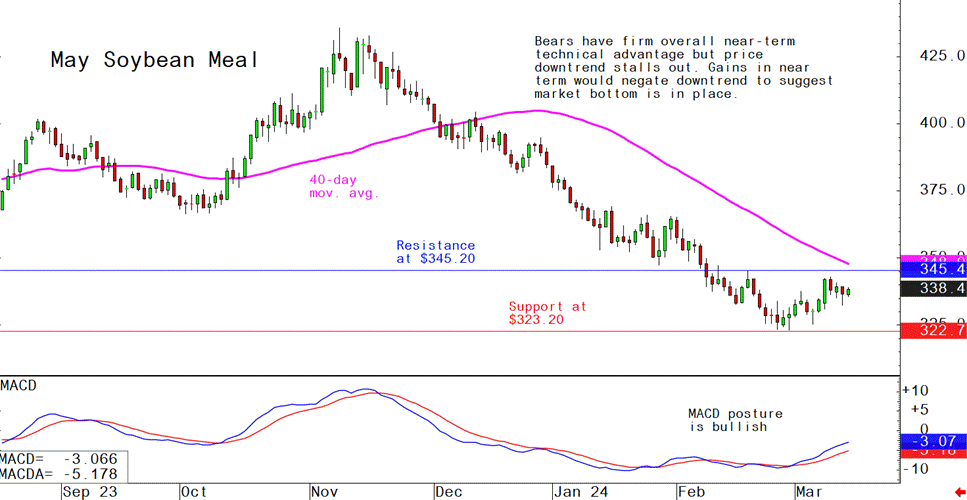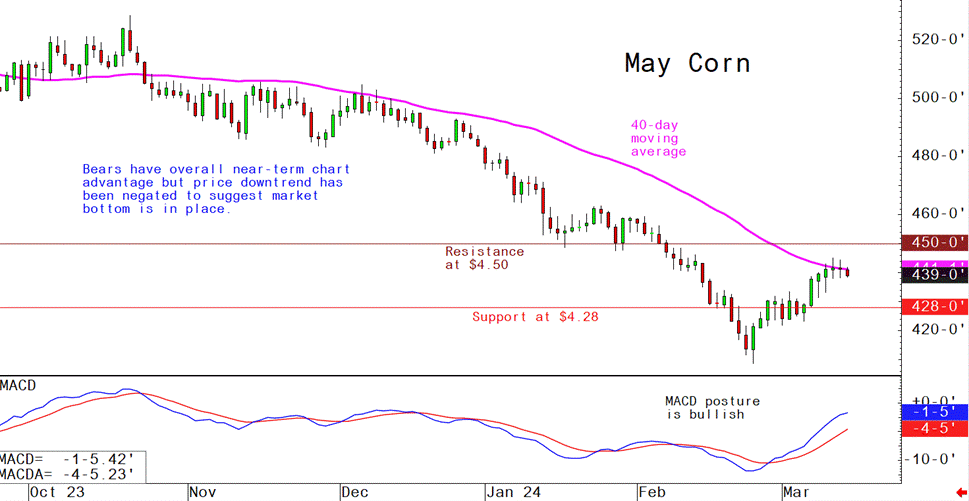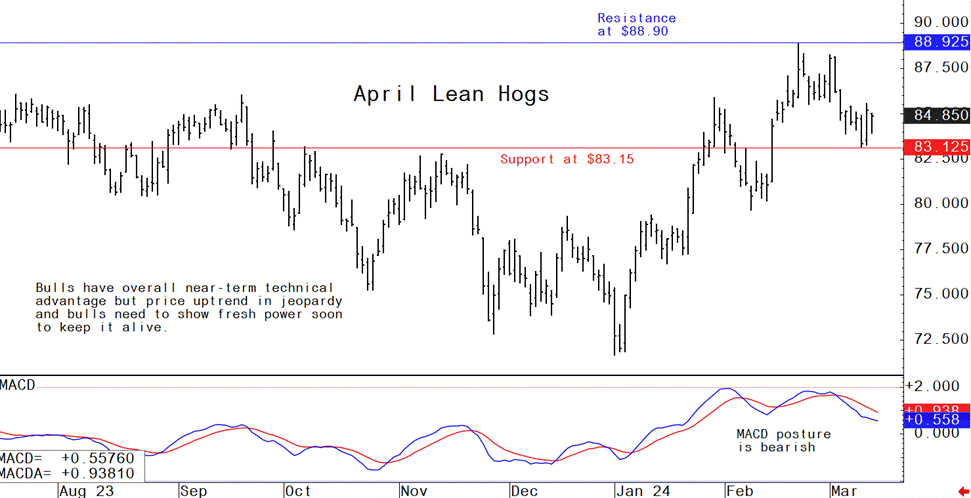



Pig outlook — Lean hog futures bulls keep price uptrend alive
Livestock analyst Jim Wyckoff reports on global pig newsApril lean hog futures prices are still in a 2.5-month-old uptrend on the daily bar chart. However, bulls need to show fresh power soon to keep their technical edge and to keep the uptrend in place. The latest CME lean hog index is up 20 cents to $81.61 (as of Mar. 11), while the preliminary calculation puts the index up another 41 cents Thursday, at $82.02. That would mark a new for-the-move high and the highest quote for the index since Oct. 12, 2023. The strength in the cash index suggests seasonal strength in the cash hog market will continue. Retailer demand for pork has been robust and is likely to continue to support cash market fundamentals in the near term.
Latest USDA and other news regarding the global pork industry
Tyson Foods announced the closure of its pork plant in Perry, Iowa
The closure will result in the loss of 1,276 jobs, with the plant scheduled to shut down on June 28. The plant, which processed approximately 9,000 hogs per day, cited a need to optimize operational efficiency to better serve customers as the reason for the closure. The United Food and Commercial Workers union represents a significant portion of the workers affected and intends to seek compensation for them. The plant has been in operation for around 60 years, and city officials are uncertain whether Tyson will consider selling the plant to another company. Tyson said it still employs 9,000 people in Iowa, and it has pork facilities in Waterloo, Storm Lake and Columbus Junction.
Iowa Gov. Kim Reynolds said Monday in a statement that “Tyson employees, the Perry community, and Iowa pork producers will have the full support of the state in the months leading up to the plant closure and after."
The Iowa Economic Development Authority and Iowa Workforce Development are "already engaged," Reynolds said. "We stand ready to assist impacted employees with finding new jobs in the area as soon as possible," with about 60,000 job openings posted on IowaWorks.gov.
US pork exports start 2024 strong, beef shipments slow
The US exported 587.8 million lbs. of pork during January. While that was down 56.1 million lbs. (8.7%) from December, which was the highest monthly tally since May 2021, pork shipments increased 32.0 million lbs. (5.8%) from January 2023. USDA raised its 2024 pork export forecast and now expects a 4.8% increase to 7.130 billion pounds. Beef exports totaled 232.6 million lbs. during January, down 19.8 million lbs. (7.8%) from December and 10.0 million lbs. (4.1%) less than last year. USDA forecasts beef exports will fall 9.1% from last year to 2.785 billion pounds.
USDA livestock and products semi-annual: China
Report Highlights: Economic headwinds will continue to impact consumption of both pork and beef in 2024. Swine and pork production in 2024 will be marginally down 3 percent as persistently low live hog and pork prices weigh on producers. However, pork imports may grow marginally to offset the forecasted decline in domestic pork production. Beef imports in 2024 could decline due to the high year-end inventory carried over into 2024 and an expected flat demand. Both swine and cattle imports could also decline due to financial challenges among producers.
EXECUTIVE SUMMARY
Swine Production: Post revised its forecast of swine production in 2024 to 695 million head with a year-on-year (YOY) decline of 3 percent due to a lower sow inventory in 2023 compared to 2022.
Swine Imports: Post revised up its forecast for swine imports in 2024 to 7,000 head based on higher-than-expected imports in 2023 despite difficult financial conditions for swine producers. Imports should still decline in 2024 from 2023 as financial difficulties and low prices continue to weigh on producers.
Swine Production to Decline Slightly
USDA revised swine production in 2024 to 695 million head with YOY decline of 3 percent due to a lower sow inventory in 2024 compared to 2023. Herd liquidation as a result of low swine and pork prices (see Chart 1 and Chart 4) and lingering animal diseases in 2023 are the two major reasons for the lower sow inventory. Swine producers started to expand swine production to rebuild their herds in 2020 and 2021 when African Swine Fever (ASF) outbreaks severely hurt the industry. The negative impacts of the large expansion of China’s swineherd manifested in 2023 when swine production exceeded market demand. Average swine prices remained low through 2023, causing losses across the swine breeding industry.
According to the National Development and Reform Commission, except for some slight profits from August to September, producers operated at a loss for most of 2023. The Ministry of Agricultural and Rural Affairs (MARA) indicated it was the first year since 2014 that swine producers suffered such large losses. Statistics of “breakeven” are from industry sources, not from the National Development and Reform Commission. 4 Industry sources reported that ASF continued affecting the sector in 2023 especially in North China. The losses for producers and news of an ASF resurgence contributed to “panic” sales resulting in a reduction of inefficient sows.
The National Bureau of Statistics (NBS) reported that the sow inventory had declined to 41.42 million at the end of 2023. Post forecasts swine production will decline in 2024. With fewer inefficient sows, the piglets weaned per sow per year (PSY) has improved. However, the improvement in PSY is unlikely to offset the lower average sow inventory in 2023. More small- and medium-sized producers exited the market due to inadequate cash flows and challenges in obtaining loans. With less swine production from smaller producers, NBS estimates the share of large-scale swine producers versus small- to mid-sized producers exceed 68 percent in 2023, with a YOY increase of about 3 percent.
Swine Imports Live Swine Imports to Remain Low
Post revised up its forecast for swine imports in 2024 to 7,000 head, but imports will still moderately decline from 2023. China imports breeding swine to improve domestic herd genetics. Imported live swine only account for around 0.001 percent of the total swine population. Most swine producers continue to be under financial pressure, making it difficult to invest in herd improvements. Additionally, despite the falling sow and swine inventory, current sow levels are above the Peoples Republic of China’s (PRC) official targets.
Industry contacts also believe current sow levels are sufficient. The main suppliers of live swine to China are the United States, Denmark, and France as they have different competitive advantages on litter size, body shape, lean meat rate, growth rate, and disease resistance. According to industry sources, swine from Denmark have the highest number of pigs per litter but lower PSY. Swine from the United States generally have larger body sizes, swine from Canada have good litter sizes, and swine from France have a good balance of growth rate and disease resistance. Swine Exports Flat to Marginal Recovery Post agrees with USDA’s official forecast for live swine exports in 2024 at 1.14 million head, with a marginal growth in exports to Hong Kong. Hong Kong and Macao will remain the top destinations for China’s live swine exports. Hong Kong is China’s largest export destination for live swine.
USDA Livestock and Products Semi-annual: European Union
EU Pork Supply Is Forecast to Rebound in 2024.
Herd Size and Pig Crop: The recent Eurostat December census reports an increase of the EU sow herd of 178,000 head in 2023, which indicates that the EU pig crop will likely recover this year. This expansion of the sow herd is triggered by record piglet and carcass prices combined with falling feed prices resulting in profitable margins for both fatteners and breeders. The pig crop is forecast to increase most significantly in Spain, Denmark, the Netherlands, and Poland.
Slaughter and Trade: While in Denmark and the Netherlands part of the additional piglet supply will be exported to other EU Member States (MSs), in Spain and Poland, most of the additional supply will be fattened and slaughtered domestically. Overall, EU slaughter is forecast to increase by 1.5 percent this year.
Pork Production: Combining the forecast slaughter level with slightly higher weights, total EU production is estimated to reach 21.2 MMT CWE in 2024. The production expansion is anticipated in Central Europe by increasing self-sufficiency, and in Western Europe, either by displacing pork in the EU domestic market, building commercial stocks, or potentially increasing sales at the global market. The third country export market is the driver for further growth of the EU swine sector.
Pork Domestic Sales and Trade: Despite an overall downward trend, the increased supply of pork on the domestic market is anticipated to support a recovery of consumption in Central Europe and the Balkan region. In the short term, EU pork prices are not competitive on the world market. Nonetheless, the restructuring and improved profitability of the EU swine sector is anticipated to support the sector’s potential to export to third countries. If the most competitive Member States (Spain, Denmark, and the Netherlands), will increase their exportable supplies, the bulk of the export expansion will be directed to the traditional top markets (China, the United Kingdom, South Korea, the Philippines, and Japan).
During 2023, slaughter of swine in official slaughterhouses fell by 7.36 percent. Swine slaughter was cut in all 27 EU Member States. In absolute terms the most significant reductions reported by Eurostat were in the western EU Member States, and most significantly in Spain, Denmark, Germany, the Netherlands, Belgium, and France. The primary question in the EU swine sector is whether slaughter reached its low point in 2023, or if the decline will continue in 2024. The cuts made by the sector in 2022 and 2023 combined were major; the piglet production was cut by 10.6 percent, and slaughter by 12.0 percent.
However, the contraction of the herd size came nearly to a standstill in 2023, which is a clear sign the swine cycle reached its low point. This is also reflected by the record prices paid for sows, piglets, and carcasses (see graph below). The further direction of EU slaughter will mainly be determined by the opportunities at the export market. The export market for EU pork is the driver for growth of the EU swine sector, which is also a distinct difference with the EU beef sector which lacks a profitable and sizeable outlet for beef in third countries. Increased supply for the EU domestic market will displace local pork production of the less competitive producers as EU domestic pork consumption has been dwindling since 2018. A domestic oversupply of pork could also result in commercial or subsidized private stock building as earlier reported in 2021 (for more information see the Pork section of this report).
Despite High Profits, the Dutch and Belgian Sectors Are Constraint by Nitrogen Regulations.
The question remains if the EU swine sector has the potential to compete at the global market. The Spanish, Dutch, and Danish swine sectors are the most competitive producers in the EU, and the top three exporters to third countries.
In these three EU MSs, recent positive fattening margins could serve as an incentive to expand the size of the hog herd. The income boost is based on the higher prices paid to the farmer for carcasses combined with the recent lower prices paid by the farmer for feed and energy. Statistics (Dutch language) from Wageningen University (WUR) reveal that the average Dutch swine farmer’s income rose from €124,000 in 2022 to €369,000 in 2023. The income of swine breeders rose even higher, from €58,000 in 2022 to €558,000 in 2023. This income boost is forecast to support a recovery of Dutch piglet production in 2024. However, significant and structural production expansion in the Netherlands is constrained by strict environmental regulations. The Dutch Government has two funding programs in place with a total budget of €1.5 billion to tempt intensive livestock farmers to sell out their farms, in an effort to bring the national nitrogen emissions down.
Spain, the largest pork exporter in the world in 2022 (in CWE), has proven to be the EU MS with the most export potential. But as with the Danish and Dutch sector, the Spanish swine sector has taken a step back in response to the lower demand from China. In 2023, Spanish slaughter declined by 6.5 percent. Other reasons for the downsizing of slaughter were the increased feed and energy prices, elevated interest rates, and tightening environmental, animal health, and animal welfare legislation. In addition, Porcine Reproductive and Respiratory Syndrome (PRRS) outbreaks were reported in Catalonia and Aragon. In 2023, producers improved their sanitary status management, and were able to bring PRRS outbreaks under control. The improved sanitary status is also expected to result in an improved piglet/sow ratio in 2024.
Spanish Swine and Pork Production Driven Down by Lower Exports and Animal Welfare Regulations.
While, according to the Spanish sector, this downward trend in swine and pork production may continue in 2023 and 2024, feed and energy prices have come down, and profit margins improved, making further investments and expansion of the capacity possible. Recent Eurostat statistics reveal an expansion of the Spanish sow herd in 2023 by more than five percent, which is anticipated to increase the Spanish pig crop and support domestic slaughter in 2024.
The expansion of the sow herd could also point to a higher self-sufficiency of piglets, and a lower dependency on imports from Northern Europe (the Netherlands and Denmark). As discussed, additional volumes of pork will in the first and foremost, displace volumes at the domestic market. But the during the past decade, the Spanish sector has heavily invested in marketing their product abroad (for more information see the Pork section of this report).
The Restructuring of the German and French Swine Sector Is Forecast to Continue in 2024.
The condition of the swine sector in Germany is typical for most other less competitive EU MSs sectors. The German sector suffered from African Swine Fever (ASF) outbreaks in the country’s wild boar population which resulted in an import ban from China. But after sharp declines in pork production in recent years, there are signs of a slight stabilization in 2023 and 2024. The main reason for this stabilization was the high prices producers received in 2023 and start of 2024.
Some industry experts believe that the exit wave of recent years was merely paused by the high prices but has not yet reached its end. Farmers continue to face major challenges due to ever-increasing demands from consumers and new legal requirements regarding animal welfare and transportation. As of 2025, a new mandatory national livestock labelling system for fattening pigs will apply. The introduction was generally welcomed by the industry since it could contribute to more animal welfare, taking the social pressure of hog farmers. Nonetheless, a solid funding concept for the conversion of farms is still missing and therefore farmers are still missing a real perspective. According to a survey (German language) conducted by the ISN almost a third of German sow farmers is planning to phase out sows in the next five to ten years.
The Swine Sector in Central Europe Is Concentrating and Forecast to Increase Production.
Despite that pork is the preferred meat, most countries in Central Europe and the Balkan region are not self-sufficient of pork. The main net pork importers in this region are Romania, Poland, the Czech Republic, Slovak Republic, and Bulgaria. Although ASF remains a prevalent feature of the swine sector in Central Europe, the outbreaks have fallen, and some MS sectors increased their investments for further commercialization of their operations to reduce the import share in the consumption. Based on this development, the Romanian pig crop production is expected to slightly increase in 2024. Because backyard farming plays an outsized role in the spread of ASF, the Romanian government approved the ‘Pig Law’ in April 2023, which prohibits breeding in Romanian backyard farms. Because fattening remains allowed, this law is not anticipated to have much of an effect on eradicating ASF.
The next week’s likely high-low price trading ranges:
April lean hog futures--$83.15 to $88.90 and with a sideways-higher bias
May soybean meal futures--$323.20 to $350.00, and with a sideways-higher bias
May corn futures--$4.21 to $4.60 and a sideways-higher bias
Latest analytical daily charts lean hog, soybean meal and corn futures












